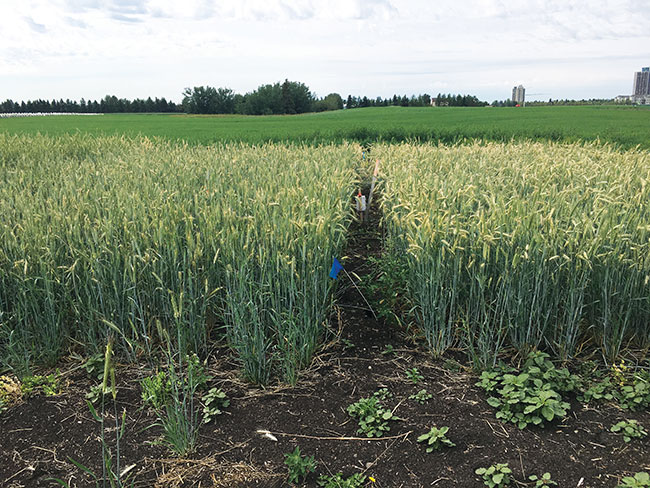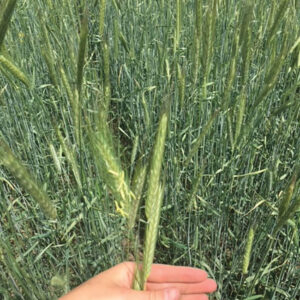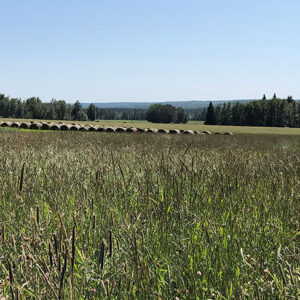
Features
Environment
An environmental powerhouse?
Perennial rye offers several benefits, and not just for the environment.
August 4, 2023 By Julienne Isaacs
 Perennial grain (left) and fall grain (right) at the Edmonton site in the summer of growing season 1.
ALL Photo courtesy of ERIN DALY.
Perennial grain (left) and fall grain (right) at the Edmonton site in the summer of growing season 1.
ALL Photo courtesy of ERIN DALY. Perennial rye, like other perennial grain crops, has an amazing list of potential benefits: it can help reduce soil erosion, enrich soil microbiota, access and use water and nutrients that might otherwise leach and store carbon.
This isn’t hearsay – it’s backed up by data. Erin Daly is a PhD candidate at the University of Alberta. She’s recently co-authored four papers based on one complex field study looking at perennial rye grain yield, agronomic benefits and challenges, impacts on soil qualities and carbon capture capabilities.
Together, these four papers paint a mostly positive picture of perennial rye. The crop has “a ways to go” in terms of winter survivability and yield, says Daly. But, by all other metrics, the crop brings significant benefits – and not just for the environment.
“For producers, they can seed just once and it grows back for two to three seasons, so they’re spending less on seed, potentially less on fertiliser and less field time,” Daly says. “[Given research investment], the grain yield will only get better and the environmental benefits will stay. We need to put a dollar value on the environmental benefits that materialise from switching to a perennial.”
Yield and survivability
Daly and her collaborators set up the trial on two sites – Edmonton and Breton, Alta. – with distinct climatic features. Breton is located an hour-and-a-half south of Edmonton, but has higher elevation and more snow cover.
The experiment was set up in a randomized complete block design at both sites, with spring rye, fall rye, perennial rye and alfalfa/meadow brome perennial forage treatments.
The agronomy component of the study aimed to assess yearly biomass and grain yields and compare the second-year perennial rye yield to those of spring rye and fall rye, notes Daly in one publication. The researchers also analyzed survival and competitiveness, as well as protein productivity and lodging potential.
“What we found was that we had reduced grain yields at both sites. We expected that because there are trade-offs when you move to perenniality, because the plant puts more resources toward surviving for multiple years,” she says. The Edmonton site saw significant winterkill thanks to a late season frost. The Breton site also had survivability issues in its second year.
“[But] we saw lots of unproductive tillers (tillers without grain), so we identified that as one way breeders could make the crop more productive,” she says.
In other words, as a viable cash crop, perennial rye isn’t there yet; more research and breeding is needed to boost yield, winter hardiness and other agronomic traits.
Soil impacts
In terms of its effects on soil, perennial rye scored far better. In another component of the study, the researchers compared soil physical quality between an annual cropping system, a perennial forage system and the perennial rye system over a three-year period. They found the perennial rye boosted soil carbon mass density and other measurements of soil physical quality versus the annual crop, although the perennial forage system provided more ecosystem services over the same timeframe.
“When we talk about soil physical quality, we measure metrics including bulk density [and] total porosity,” says Daly. “When we switch to a no-till situation, you often see short-term increases in bulk density, but what we found was the perennial grain treatment wasn’t seeing increases in bulk density, so it was able to counteract those temporary effects we see when we switch from full tillage to no tillage.”
In yet more experiments based in the same plots, Daly and her colleagues found perennial rye was much more effective at stabilizing soil organic carbon and “substantially increased” carbon sequestration relative to annual crops; and also that perennial rye was able to reduce nitrous oxide emissions by reducing available soil N.
“We saw nitrous oxide [emissions] drop by 95 per cent in the perennial grain crop system,” says Daly, “because the crops are able to capture it with their extensive root system. Those roots take up nitrogen in the soil before it can be converted to nitrous oxide.”
Without adequate yields, the environmental benefits alone may not be enough to convince many farmers to take on perennial rye.
But, Daly is perennially hopeful. Natural perennial grasslands can be incredibly healthy, she says, and it’s possible to mimic some characteristics of those systems. The rest will simply take time.
“Wheat was domesticated 11,000 years ago,” she says. “Canola was domesticated [about] 60 years ago. We still need 20 to 30 years of breeding cycles to fully realize the potential of perennial grains.
“We’re not 100 per cent there yet, but it’s realistic.”

